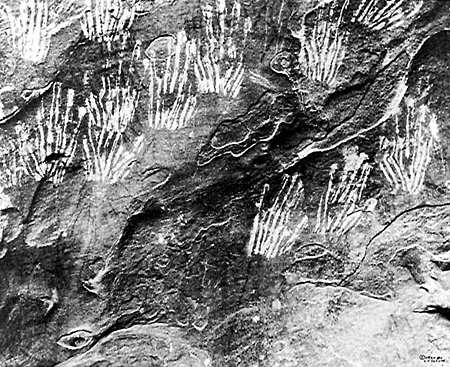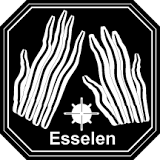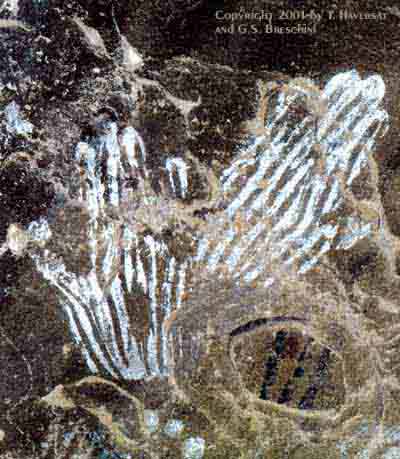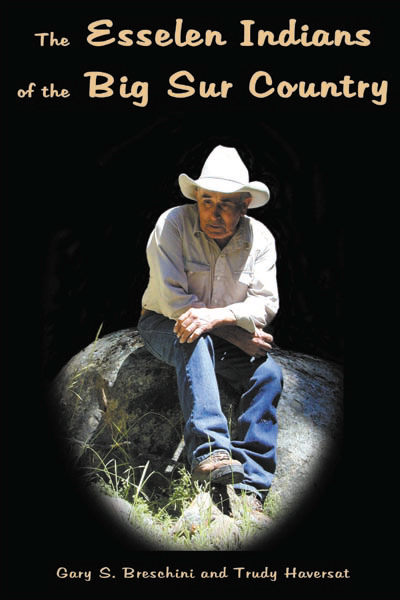Esselen Indians
from the Tassajara Area
and the hands in the cave near Church Creek Ranch
and Robinson Jeffers' poem
 Official Esselen Nation website
Official Esselen Nation website
The Esselen People and Their Fate by David Rogers
Esselen Indians on the Esalen Institute site
Monterey Historical Society on the Esselen Indians
On Esselen
Indians from Big Sur California dot org with photos of the hands
near Church Creek
A 2011 email from Lyndon Comstock who's done work on Tassajara and Esselen history. (below)
Cave of the Hands video on Youtube
Fred appears on this page of Tassajara fire history with history of fire in he general area from Cachagua and Jamesberg to Big Sur.
Fred's son Little Bear Tommy is a good friend of Tassajara and has done a lot of bulldozer and backhoe work there.
The name Tassajara has been reported by several sources to be an Indian word meaning a place where meat is hung to dry. Peter Schneider wrote that in the sixties in a Wind Bell.
From Wikipedia:
Tasajera is a Spanish-American word derived from an indigenous Esselen language, which designates a "place where meat is hung to dry."[1] It has also been known as Tassajara Springs, Tesahara Springs and on mining claims as Agua Caliente.
Gudde, Erwin G. (2004). California Place Names: the Origin and Etymology of Current Geographical Names (fourth ed.). Berkeley, California: University of California Press. ISBN 978-0-520-24217-3.
The Story of Indian Bones (found at Tassajara) PDF - Gene deSmidt in the Winter 1995 Wind Bell - read it on his site in the Tassajara Project section
The mural at Tassajara telling a version of the Indian legend of Tassajara's hot spring water - and a painting on a rock
Esselen logo (or whatever it's called)
 The Esselen were one of the least numerous groups in California, and are often cited, incorrectly, as the first California Indian group to become culturally extinct. This picture of Esselen extinction, although pervasive in the literature, is wrong. Not only did the group not become extinct, there is even recent evidence that some Esselen escaped the missions entirely by retreating to the rugged interior mountains. It now appears that a small group survived into the 1840s before filtering to the ranchos and the outskirts of the growing towns.
The Esselen were one of the least numerous groups in California, and are often cited, incorrectly, as the first California Indian group to become culturally extinct. This picture of Esselen extinction, although pervasive in the literature, is wrong. Not only did the group not become extinct, there is even recent evidence that some Esselen escaped the missions entirely by retreating to the rugged interior mountains. It now appears that a small group survived into the 1840s before filtering to the ranchos and the outskirts of the growing towns.
Most of the extant data on the Esselen has been gathered into one place, in a new book from Coyote Press. In addition to subjects directly related to the Esselen people, it contains a great deal of information on the natural history of the region.
Breschini, G. S. and T. Haversat (2004). The Esselen Indians of the Big Sur Country: The Land and the People. Available from Coyote Press, Salinas.
That's Fred Nason on the cover. Hi Fred.
The Esselen (Spotlight on the American Indians of California)
by Miranda Rathjen, a children's book -
Amazon page
Robinson Jeffers' poem:
HANDS
Inside a cave in a narrow canyon near Tassajara
The vault of rock is painted with hands,
A multitude of hands in the twilight, a cloud of men's palms, no
more,
No other picture. There's no one to say
Whether the brown shy quiet people who are dead intended
Religion or magic, or made their tracings
In the idleness of art; but over the division of years these careful
Signs-manual are now like a sealed message
Saying "Look: we also were human; we had hands, not paws. All hail
You people with the cleverer hands, our supplanters
In the beautiful country; enjoy her a season, her beauty, and come
down
And be supplanted; for you also are human."
From Dear Judas and Other Poems, Horace Liverright, New York, 1929.
From Lyndon Comstock on Esselen History
I'm contacting you as a historian of sorts of Tassajara, SFZC, and so forth. I don't know if your interests extend as far as the Esselen people but, in case they do, or in case there are others at Tassajara who are interested.
Of course you're aware that the Esselen people were in the Tassajara area until the early 19th century. Something that I hadn't known and perhaps you hadn't either, is that there were a few interesting bits of information collected about the Esselen from early anthropologists. As one of these tidbits:
Maria Viviena Soto (1823-1916) was an informant to Alfred Kroeber in 1902. She was not herself Esselen (Kroeber called her Costanoan, she called herself Sureno) ) but she was familiar with some of Esselen culture because of the intermixing that had taken place at the Carmel mission during the mission era--her parents had lived through the second half of that era. In Kroeber's field notes she describes Agua Caliente, that is Tassajara: "The Esselenes lived at Agua Caliente but were all brought to Carmelo by Padre Junipero and lived there." (Kroeber notebook 26, p. 82, Bancroft library, UC Berkeley. On p. 30, Kroeber specifically identifies Agua Caliente as Tassajara Hot Springs) That is, according to her, Tassajara was the principal place of the Esselen immediately prior to the mission period. Maria's niece Jacinta Gonzalez said simply "the Esselenes were from Hot Springs."
Alfred Kroeber made some field recordings on wax cylinders in 1902 of Maria Viviena Soto singing. These are now held at the Hearst anthropology museum (in Kroeber Hall) at U.C Berkeley and digital copies are available--I have them myself. Although not an Esselen, she sang a couple of Esselen songs. Catalog 24-525 is an Esselen deer dancing song. Kroeber's notes from Soto comment, "Deer danced and sung thus. (She) does not know what words mean. Is dancing song of Esselenes. Maybe the deer are Esselenes. Men & women danced this. Had deer, coyote, bear, etc. songs in dances, dressed alike for all. In bear-song dance, however, something to resemble pants was worn." There was another song, 24-537, that Soto also described as a dancing song of the Esselenes.
Of course, there are other sources, both on the web and in books, about the Esselen people, but I thought these were interesting. You've probably already heard the reports that there were Esselen people who hid out in the area throughout the mission era and that some bones were found in a cave dated to 1815.
Thanks for your book about Suzuki Roshi--I enjoyed reading it some time back.
Lyndon Comstock Bolinas, CA

